Crack Climbing Technique: The Ultimate Beginner’s Guide (2024)
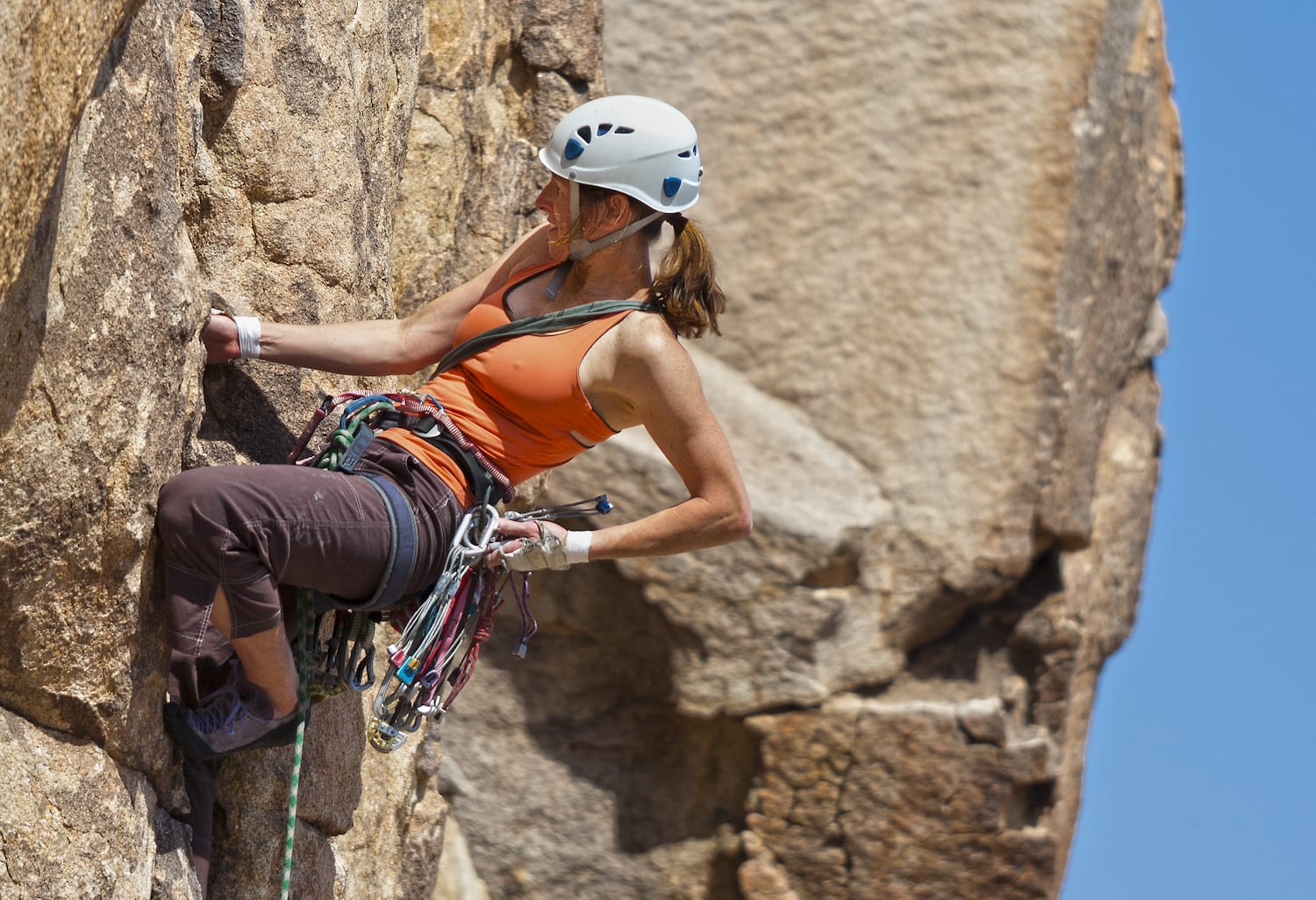
Published on: 09/12/2023
Crack climbing is a form of rock climbing in which the climber jams their body into cracks in the rock in order to ascend. When you’re face climbing, you ascend the rock by pulling on holds like edges or jugs. When you’re crack climbing you instead wedge your hands and feet into the space in the crack to move upwards.
Cracks are usually protectable with traditional climbing gear. Therefore, in most areas, climbing ethics recommend that bolts should not be placed if the route can be protected naturally. Nonetheless, bolted crack climbs exist and can be a good introduction to the discipline.

Origins and history
Climbing existed long before sport climbing. This means that for decades, climbers were only able to climb routes that could be protected with trad gear. Thus, crack climbing was vital to the birth of rock climbing.
In the first half of the 19th century, climbers began to ascend crack systems using ropes. However, the gear they used to protect these routes was nothing like the cams that exist today. In the 1920s, some climbers would carry rocks which they would slot into cracks and tie cord to (1).
Crack climbing continued to blossom as nuts and hexes were invented in the 60s and 70s. Until sport climbing began flourishing in the 1980s, climbing cracks was basically the only roped climbing you could do.
Climbing legends like Peter Croft got their start crack climbing. Other famous climbers like Lynn Hill and Alex Honnold also excel in it. And while sport climbing meccas like Smith Rock and the Red River Gorge have become popular since people began bolting routes, crack climbing remains an important discipline in rock climbing. Areas like Joshua Tree, Indian Creek and Yosemite have beautiful rock faces that you’ll miss out on if you never learn this skill.

Safety
Crack climbing is not inherently dangerous, and well-protectable cracks can be even safer than bolted sport routes since the climber can place as much gear as they like. However, the natural features of some cracks can make gear difficult to place. Additionally, assuming the crack is not bolted, crack climbing requires the rock climber to understand how to place cams and nuts. Therefore, it demands more technical skills than face climbing in order to stay safe.
This means that the risks involved with crack climbing are different from that of other types of rock climbing. Data (2) suggests that most traditional climbing injuries are due to falls, while sport climbing injuries tend to result from difficult moves. This is because crack climbing involves less pulling and crimping than sport climbing. Good crack climbers use minimal strength and hang from their jams instead of pulling themselves up. So while you might be safe from pulley sprains or elbow tendonitis when you go crack climbing, make sure you are confident placing gear if you are leading. You also might find that your limbs get a bit scraped up from crack climbing!
Crack Climbing Technique
There are many different techniques needed to crack climb, depending on the size of the crack. In general, you need to figure out how to make various body parts fill the crack; this is called a jam. Think about using your body like a camming device. Instead of grabbing holds, you jam your way upwards!
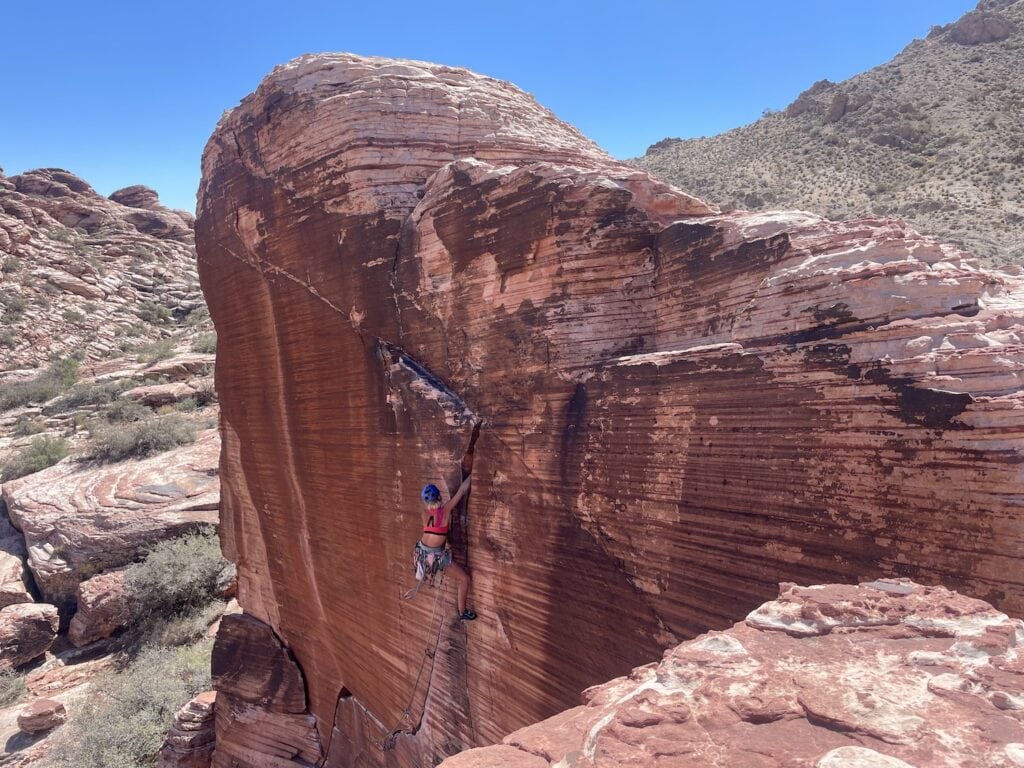
Hand jams
One of the most common jamming techniques is a hand jam. This technique is used in hand cracks, a size of crack in which you can fit an entire sideways hand. The general principle here is that you insert your hand into the crack up to wrist depth. Insert your hand in its thinnest orientation and then cup it until it fills up the space. The jam creates outwards pressure on the crack walls enabling the climber to make upward progress.
When performing a hand jam, you want to think about your hand having three points of contact with the rock:
- Your finger tips
- The knuckles on the back of your hand
- Meaty part of your hand at the base of your thumb.
If you have minimal surface area contact, the jam will feel less secure. To jam correctly, try to maximize the contact in those three spots and create opposing pressure against the crack walls. You can perform hand jams with your hand in a thumb up or thumb down orientation. A good hand jam requires minimal strength and can feel solid enough to be used as a good rest!
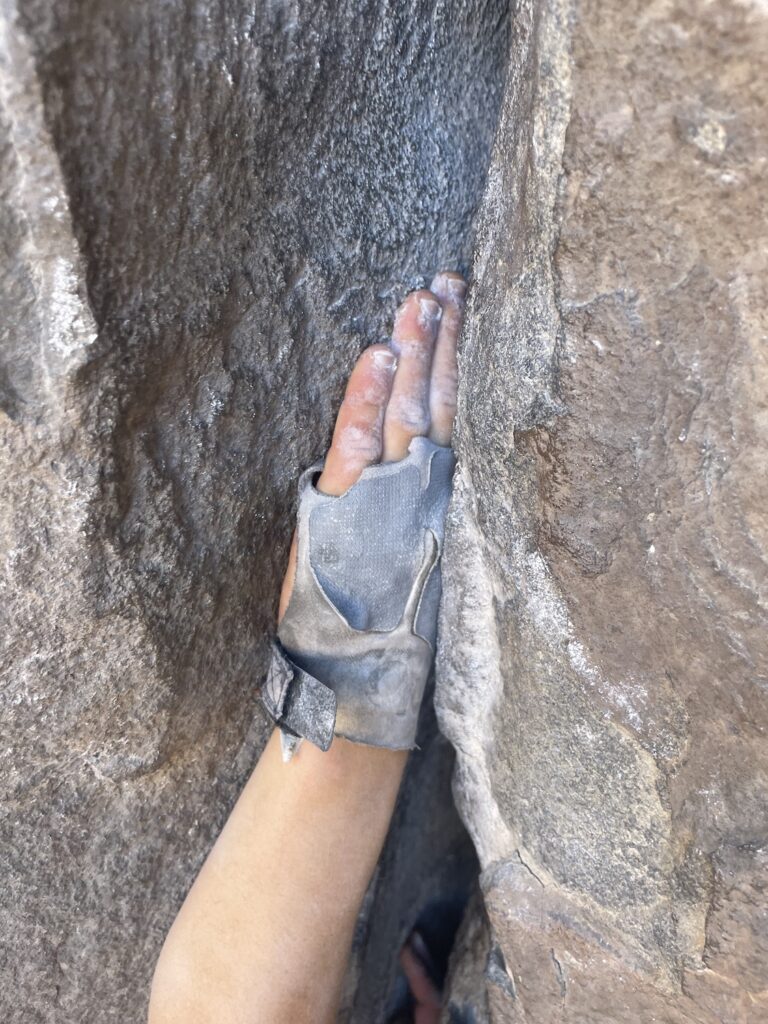
“Perfect” and “thin” hands
There are various types of hand jams depending on the crack size. When someone says a crack is “perfect hands,” it’s a size where hand jams feel the most secure. Perfect hands for someone else may not be perfect for you– it really depends on hand size.
In a wide hand crack, you’ll have to cup your hands more for your jam to fill the space. This can make the jam feel less secure– it’s no longer perfect hands. But the same principles apply: use the soft tissue of your hand to create friction against the crack walls. Thumbs up jams usually work better for wide hands.
When a hand crack is thinner than perfect hands, that’s what’s called “thin hands”. While thumbs up jams tend to work better in wide hand cracks, thumbs down jams tend to work better in thinner cracks. Indeed, they allow you to use more of the meaty thumb part of your hand in your jam.
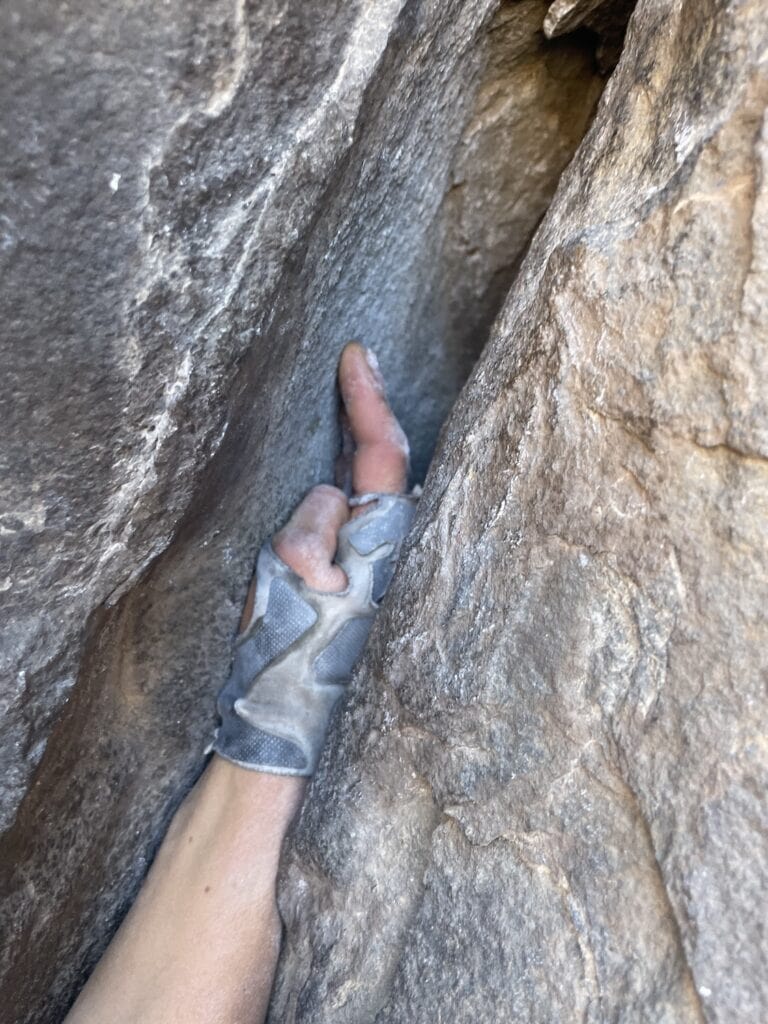
Fist jams
Given the wide variation in crack systems, there are many different crack climbing jams that can be used. They all rely on exactly the same principles as hand cracks, but you use different body parts depending on crack size.
If a cupped hand doesn’t fill up the crack, it’s time to use a fist jam. The principles for climbing a fist crack are pretty simple: just use a sideways fist to fill the space. You can perform fist jams with either your palm up or your palm down, depending on what feels better. Squeeze your fist and use all the meaty parts of your hand to create a solid jam.
Finger jams
So if a crack is too wide for a hand jam, the next thing to try is a fist jam. But what if the crack is too small for a hand? This is called a finger crack. Climbing finger cracks can be more physical than other crack climbing, but it still demands good technique.
To climb a finger crack you’ll need to use what’s called a finger jam. Here’s how to perform this technique:
- Orient your hand so that the index finger is furthest down and your little finger is on top
- Insert as much of your fingers as possible inside the crack
- Twist the elbow down so it’s in line with the crack.
This is a finger lock, and it can feel quite solid if you can get your second or third knuckle into the crack. If less than this fits, it’s called a “tips crack.” There’s barely any surface area of skin in contact with the rock, so it’s very challenging to climb.
Using a finger jam can sometimes be painful, but knowing this technique will come in handy in many arenas of rock climbing.
Chimneys and off-width cracks
There are two types of cracks that are even wider than fist cracks: off width cracks and chimneys. If you can fit your whole body in the crack, that’s a chimney. In order to ascend, you simply wedge your body against the two walls of the crack and scoot your way up a few inches at a time– kind of like an entire body jam.

If the crack is too small for your whole body but too big for a fist jam, it’s called an off width crack. Off width jams require a variety of advanced techniques we won’t cover in this article. It’s typical to start by learning the more straightforward sizes of cracks before diving into the world of off-widths.
Foot jams
When you’re climbing cracks, you often need to use the crack as a foothold as well as a handhold. This is called a foot jam. To execute this technique:
- Insert your foot inside the crack sideways with your pinky toe down and your big toe up
- Twist your leg in such a way that your knee is in line with your foot.
When you first insert your foot it won’t make much sense, but when your knees start twisting you’ll feel the foot jam start to work.
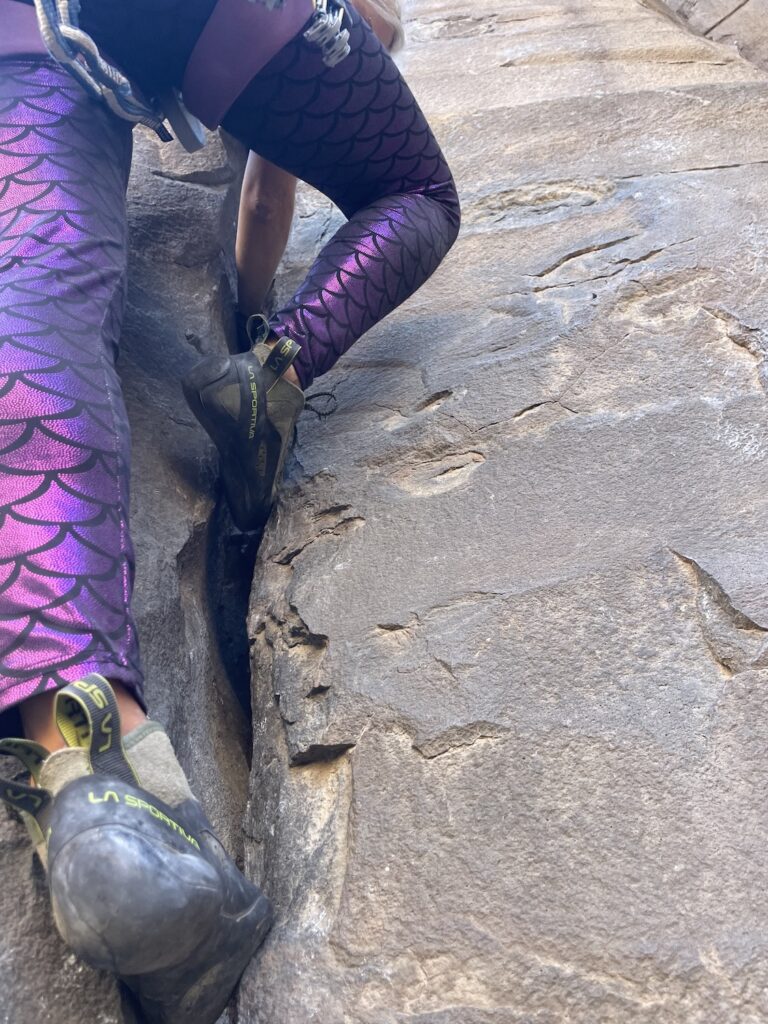
Body position
For effective jamming, the climber’s body must be well-positioned. The most important thing to keep in mind is to keep your body and your limbs in line with the crack. If your elbows or knees are pointing outwards, you’ll probably end up falling.
Instead of pulling yourself up the wall, you should use downwards force to hang from your body when you’re crack climbing. One common mistake that beginner crack climbers make is trying to pull outwards on their jams instead of hanging on them. To help avoid this, try to jam above your chest so your body weight puts downward force on your jam. But you also don’t want to be overly stretched out– it’s usually not ideal to jam as high up in the crack as you can possibly reach. For maximum climbing efficiency, try jamming a bit above head level, set your jam well, and keep your arms straight.
If you’re using finger or hand jams, look for constrictions in the rock and place your jam in the constriction like you would a nut. This way, you can use the natural features and friction of the rock to increase the holding power of your jam.
Crack Climbing Gear
Gloves/tape
When climbing hand cracks, most people prefer to use some type of skin protection to avoid scraping the backs of their hands. Crack gloves are an excellent way to do this. Overall, they’re a good investment for anyone who wants to crack climb regularly.
If you aren’t ready to purchase gloves, you can make your own tape gloves using wide athletic tape. Some people also use tape on their index fingers when they climb finger cracks, as finger jams can scrape your skin.

Comfortable climbing shoes
It’s important to have the right climbing shoes for cracks. While an aggressive shoe may help you climb hard boulders, it will hold you back in a crack. Indeed, it’s painful to jam in such shoes.
Instead, opt for flat and comfortable shoes. Many people also prefer stiff climbing shoes for jamming because they protect your feet more than soft shoes do. A stiff and flat shoe also tends to be good at standing on small edges. This can prove useful as some crack routes have face holds around the crack that can be used for footholds.
Lastly, a lace-up shoe is preferable to Velcro — you don’t want the straps to get caught and open while performing a foot jam.
Route protection
Since most crack climbs tend to require trad gear, it’s important to have the proper equipment if you are going to lead the route. And even if you are just setting up a top rope, you’ll need to build an anchor and ensure a safe rope setup.
Learn more about the different types of climbing protection here.
How to Start Crack Climbing
It can feel intimidating to start crack climbing, but there are lots of ways to learn in a low-risk environment.
If you have a climbing partner who is comfortable leading cracks, try climbing easy cracks on a top rope. Many gyms will also have routes or boulder problems that involve a crack section, so this can be a good way to learn as well. Finding a clinic in your area is another good option. Lastly, consider paying for a guiding service that can take you out on some crack routes.
Beginner crack climbing areas
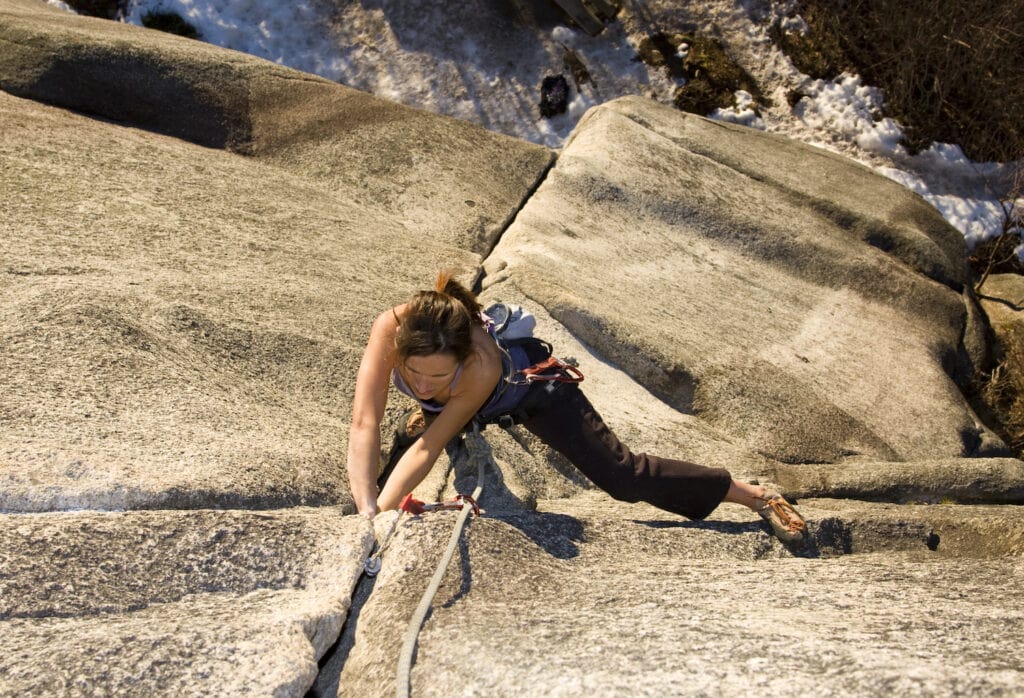
Some crack climbing areas are better for beginners than other. Here are some areas to check out if you’re new to crack climbing:
Squamish (BC, Canada)
Squamish has lots of easy cracks that are approachable for beginners, and both the climbing and the gear tends to be intuitive at the lower grades.
Indian Creek (FL)
This place is a classic for a reason. Although Indian Creek has limited routes under 5.10/5c, the splitter nature of the cracks means that both the techniques and the gear are straightforward. I’ve heard it referred to as “sport climbing on gear.”
Red River Gorge (KY)
Although the Red is best known for its sport climbing, it also has quite a few crack routes. And with over 150 traditional routes under 5.10/5c, it’s not a bad place for beginners to learn.
References
Climbing Accidents—Prospective Data Analysis from the International Alpine Trauma Registry and Systematic Review of the Literature
Rauch et al. (2020)
International Journal of Environmental Research and Public Health
https://www.ncbi.nlm.nih.gov/pmc/articles/PMC6981967/
Before “the Nut” There Was “the Pebble”… and It Was Sketchy
Jeff Achey (April 2022)
Climbing Magazine
https://www.climbing.com/gear/the-nut-chronicles/
